History of science
| Part of a series on |
| Science |
|---|
| This is a subseries on philosophy. In order to explore related topics, please visit navigation. |
The history of science covers the development of science from ancient times to the present. It encompasses all three major branches of science: natural, social, and formal.[1] Protoscience, early sciences, and natural philosophies such as alchemy and astrology during the Bronze Age, Iron Age, classical antiquity, and the Middle Ages declined during the early modern period after the establishment of formal disciplines of science in the Age of Enlightenment.
Science's earliest roots can be traced to
Natural philosophy was transformed during the
Approaches to history of science
The nature of the history of science is a topic of debate (as is, by implication, the definition of science itself). The history of science is often seen as a linear story of progress[27] but historians have come to see the story as more complex.[28][29][30] Alfred Edward Taylor has characterised lean periods in the advance of scientific discovery as "periodical bankruptcies of science".[31]
Science is a human activity, and scientific contributions have come from people from a wide range of different backgrounds and cultures. Historians of science increasingly see their field as part of a global history of exchange, conflict and collaboration.[32]
The
Historians have emphasized[citation needed] that trust is necessary for agreement on claims about nature. In this light, the 1660 establishment of the Royal Society and its code of experiment – trustworthy because witnessed by its members – has become an important chapter in the historiography of science.[37] Many people in modern history (typically women and persons of color) were excluded from elite scientific communities and characterized by the science establishment as inferior. Historians in the 1980s and 1990s described the structural barriers to participation and began to recover the contributions of overlooked individuals.[38][39] Historians have also investigated the mundane practices of science such as fieldwork and specimen collection,[40] correspondence,[41] drawing,[42] record-keeping,[43] and the use of laboratory and field equipment.[44]
Prehistoric times
In prehistoric times, knowledge and technique were passed from generation to generation in an oral tradition. For instance, the domestication of maize for agriculture has been dated to about 9,000 years ago in southern Mexico, before the development of writing systems.[45][46][47] Similarly, archaeological evidence indicates the development of astronomical knowledge in preliterate societies.[48][49]
The oral tradition of preliterate societies had several features, the first of which was its fluidity.[2] New information was constantly absorbed and adjusted to new circumstances or community needs. There were no archives or reports. This fluidity was closely related to the practical need to explain and justify a present state of affairs.[2] Another feature was the tendency to describe the universe as just sky and earth, with a potential underworld. They were also prone to identify causes with beginnings, thereby providing a historical origin with an explanation. There was also a reliance on a "medicine man" or "wise woman" for healing, knowledge of divine or demonic causes of diseases, and in more extreme cases, for rituals such as exorcism, divination, songs, and incantations.[2] Finally, there was an inclination to unquestioningly accept explanations that might be deemed implausible in more modern times while at the same time not being aware that such credulous behaviors could have posed problems.[2]
The development of writing enabled humans to store and communicate knowledge across generations with much greater accuracy. Its invention was a prerequisite for the development of philosophy and later science in ancient times.[2] Moreover, the extent to which philosophy and science would flourish in ancient times depended on the efficiency of a writing system (e.g., use of alphabets).[2]
Earliest roots in the Ancient Near East
The earliest roots of science can be traced to the Ancient Near East, in particular Ancient Egypt and Mesopotamia in around 3000 to 1200 BCE.[2]
Ancient Egypt
Number system and geometry
Starting in around 3000 BCE, the ancient Egyptians developed a numbering system that was decimal in character and had oriented their knowledge of geometry to solving practical problems such as those of surveyors and builders.
Disease and healing
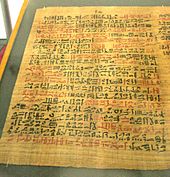
Egypt was also a center of
Calendar
The ancient Egyptians even developed an official calendar that contained twelve months, thirty days each, and five days at the end of the year.[2] Unlike the Babylonian calendar or the ones used in Greek city-states at the time, the official Egyptian calendar was much simpler as it was fixed and did not take lunar and solar cycles into consideration.[2]
Mesopotamia
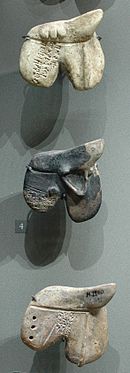
The ancient Mesopotamians had extensive knowledge about the
Mesopotamian medicine
The ancient
Astronomy and celestial divination

In
To the Babylonians and other Near Eastern cultures, messages from the gods or omens were concealed in all natural phenomena that could be deciphered and interpreted by those who are adept.[2] Hence, it was believed that the gods could speak through all terrestrial objects (e.g., animal entrails, dreams, malformed births, or even the color of a dog urinating on a person) and celestial phenomena.[2] Moreover, Babylonian astrology was inseparable from Babylonian astronomy.
Mathematics
The Mesopotamian cuneiform tablet Plimpton 322, dating to the eighteenth-century BCE, records a number of Pythagorean triplets (3,4,5) (5,12,13) ...,[61] hinting that the ancient Mesopotamians might have been aware of the Pythagorean theorem over a millennium before Pythagoras.[62][63][64]
Ancient and medieval South Asia and East Asia
Mathematical achievements from Mesopotamia had some influence on the development of mathematics in India, and there were confirmed transmissions of mathematical ideas between India and China, which were bidirectional.[65] Nevertheless, the mathematical and scientific achievements in India and particularly in China occurred largely independently[66] from those of Europe and the confirmed early influences that these two civilizations had on the development of science in Europe in the pre-modern era were indirect, with Mesopotamia and later the Islamic World acting as intermediaries.[65] The arrival of modern science, which grew out of the Scientific Revolution, in India and China and the greater Asian region in general can be traced to the scientific activities of Jesuit missionaries who were interested in studying the region's flora and fauna during the 16th to 17th century.[67]
India

Indian astronomy and mathematics
The earliest traces of mathematical knowledge in the Indian subcontinent appear with the Indus Valley Civilisation (c. 4th millennium BCE ~ c. 3rd millennium BCE). The people of this civilization made bricks whose dimensions were in the proportion 4:2:1, which is favorable for the stability of a brick structure.[68] They also tried to standardize measurement of length to a high degree of accuracy. They designed a ruler—the Mohenjo-daro ruler—whose unit of length (approximately 1.32 inches or 3.4 centimetres) was divided into ten equal parts. Bricks manufactured in ancient Mohenjo-daro often had dimensions that were integral multiples of this unit of length.[69]
Indian astronomer and mathematician
In the
The first textual mention of astronomical concepts comes from the
Grammar
Some of the earliest linguistic activities can be found in
Medicine
Findings from Neolithic graveyards in what is now Pakistan show evidence of proto-dentistry among an early farming culture.[78] The ancient text Suśrutasamhitā of Suśruta describes procedures on various forms of surgery, including rhinoplasty, the repair of torn ear lobes, perineal lithotomy, cataract surgery, and several other excisions and other surgical procedures.
Politics and state
An ancient Indian treatise on statecraft, economic policy and military strategy by Kautilya[79] and Viṣhṇugupta,[80] who are traditionally identified with Chāṇakya (c. 350–283 BCE). In this treatise, the behaviors and relationships of the people, the King, the State, the Government Superintendents, Courtiers, Enemies, Invaders, and Corporations are analyzed and documented. Roger Boesche describes the Arthaśāstra as "a book of political realism, a book analyzing how the political world does work and not very often stating how it ought to work, a book that frequently discloses to a king what calculating and sometimes brutal measures he must carry out to preserve the state and the common good."[81]
China
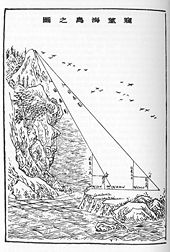
Chinese mathematics
From the earliest the Chinese used a positional decimal system on counting boards in order to calculate. To express 10, a single rod is placed in the second box from the right. The spoken language uses a similar system to English: e.g. four thousand two hundred and seven. No symbol was used for zero. By the 1st century BCE, negative numbers and decimal fractions were in use and
Although the first attempts at an axiomatization of geometry appear in the
Astronomical observations
Astronomical observations from China constitute the longest continuous sequence from any civilization and include records of sunspots (112 records from 364 BCE), supernovas (1054), lunar and solar eclipses. By the 12th century, they could reasonably accurately make predictions of eclipses, but the knowledge of this was lost during the Ming dynasty, so that the Jesuit
From antiquity, the Chinese used an equatorial system for describing the skies and a star map from 940 was drawn using a cylindrical (Mercator) projection. The use of an armillary sphere is recorded from the 4th century BCE and a sphere permanently mounted in equatorial axis from 52 BCE. In 125 CE Zhang Heng used water power to rotate the sphere in real time. This included rings for the meridian and ecliptic. By 1270 they had incorporated the principles of the Arab torquetum.
In the
Inventions

To better prepare for calamities, Zhang Heng invented a seismometer in 132 CE which provided instant alert to authorities in the capital Luoyang that an earthquake had occurred in a location indicated by a specific cardinal or ordinal direction.[85][86] Although no tremors could be felt in the capital when Zhang told the court that an earthquake had just occurred in the northwest, a message came soon afterwards that an earthquake had indeed struck 400 to 500 km (250 to 310 mi) northwest of Luoyang (in what is now modern Gansu).[87] Zhang called his device the 'instrument for measuring the seasonal winds and the movements of the Earth' (Houfeng didong yi 候风地动仪), so-named because he and others thought that earthquakes were most likely caused by the enormous compression of trapped air.[88]
There are many notable contributors to early Chinese disciplines, inventions, and practices throughout the ages. One of the best examples would be the medieval Song Chinese
The
However, cultural factors prevented these Chinese achievements from developing into "modern science". According to Needham, it may have been the religious and philosophical framework of Chinese intellectuals which made them unable to accept the ideas of laws of nature:
It was not that there was no order in nature for the Chinese, but rather that it was not an order ordained by a rational personal being, and hence there was no conviction that rational personal beings would be able to spell out in their lesser earthly languages the divine code of laws which he had decreed aforetime. The
Taoists, indeed, would have scorned such an idea as being too naïve for the subtlety and complexity of the universe as they intuited it.[94]
Pre-Columbian Mesoamerica
During the
Classical antiquity and Greco-Roman science
The contributions of the Ancient Egyptians and Mesopotamians in the areas of astronomy, mathematics, and medicine had entered and shaped
Pre-socratics
The earliest
Natural philosophy
Plato and Aristotle produced the first systematic discussions of natural philosophy, which did much to shape later investigations of nature. Their development of deductive reasoning was of particular importance and usefulness to later scientific inquiry. Plato founded the Platonic Academy in 387 BCE, whose motto was "Let none unversed in geometry enter here," and also turned out many notable philosophers. Plato's student Aristotle introduced empiricism and the notion that universal truths can be arrived at via observation and induction, thereby laying the foundations of the scientific method.[106] Aristotle also produced many biological writings that were empirical in nature, focusing on biological causation and the diversity of life. He made countless observations of nature, especially the habits and attributes of plants and animals on Lesbos, classified more than 540 animal species, and dissected at least 50.[107] Aristotle's writings profoundly influenced subsequent Islamic and European scholarship, though they were eventually superseded in the Scientific Revolution.[108][109]
Aristotle also contributed to theories of the elements and the cosmos. He believed that the celestial bodies (such as the planets and the Sun) had something called an unmoved mover that put the celestial bodies in motion. Aristotle tried to explain everything through mathematics and physics, but sometimes explained things such as the motion of celestial bodies through a higher power such as God. Aristotle did not have the technological advancements that would have explained the motion of celestial bodies.[110] In addition, Aristotle had many views on the elements. He believed that everything was derived of the elements earth, water, air, fire, and lastly the Aether. The Aether was a celestial element, and therefore made up the matter of the celestial bodies.[111] The elements of earth, water, air and fire were derived of a combination of two of the characteristics of hot, wet, cold, and dry, and all had their inevitable place and motion. The motion of these elements begins with earth being the closest to "the Earth," then water, air, fire, and finally Aether. In addition to the makeup of all things, Aristotle came up with theories as to why things did not return to their natural motion. He understood that water sits above earth, air above water, and fire above air in their natural state. He explained that although all elements must return to their natural state, the human body and other living things have a constraint on the elements – thus not allowing the elements making one who they are to return to their natural state.[112]
The important legacy of this period included substantial advances in factual knowledge, especially in
of the modern day. Neither reason nor inquiry began with the Ancient Greeks, but the Socratic method did, along with the idea of Forms, give great advances in geometry, logic, and the natural sciences. According to Benjamin Farrington, former professor of Classics at Swansea University:- "Men were weighing for thousands of years before Archimedes worked out the laws of equilibrium; they must have had practical and intuitional knowledge of the principals involved. What Archimedes did was to sort out the theoretical implications of this practical knowledge and present the resulting body of knowledge as a logically coherent system."
and again:
- "With astonishment we find ourselves on the threshold of modern science. Nor should it be supposed that by some trick of translation the extracts have been given an air of modernity. Far from it. The vocabulary of these writings and their style are the source from which our own vocabulary and style have been derived."[115]
Greek astronomy
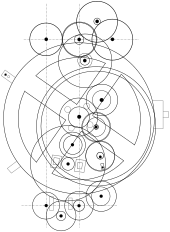
The astronomer Aristarchus of Samos was the first known person to propose a heliocentric model of the Solar System, while the geographer Eratosthenes accurately calculated the circumference of the Earth. Hipparchus (c. 190 – c. 120 BCE) produced the first systematic star catalog. The level of achievement in Hellenistic astronomy and engineering is impressively shown by the Antikythera mechanism (150–100 BCE), an analog computer for calculating the position of planets. Technological artifacts of similar complexity did not reappear until the 14th century, when mechanical astronomical clocks appeared in Europe.[116]
Hellenistic medicine
There was not a defined societal structure for healthcare during the age of Hippocrates.[117] At that time, society was not organized and knowledgeable as people still relied on pure religious reasoning to explain illnesses.[117] Hippocrates introduced the first healthcare system based on science and clinical protocols.[118] Hippocrates' theories about physics and medicine helped pave the way in creating an organized medical structure for society.[118] In medicine, Hippocrates (c. 460 BC – c. 370 BCE) and his followers were the first to describe many diseases and medical conditions and developed the Hippocratic Oath for physicians, still relevant and in use today. Hippocrates' ideas are expressed in The Hippocratic Corpus. The collection notes descriptions of medical philosophies and how disease and lifestyle choices reflect on the physical body.[118] Hippocrates influenced a Westernized, professional relationship among physician and patient.[119] Hippocrates is also known as "the Father of Medicine".[118]Herophilos (335–280 BCE) was the first to base his conclusions on dissection of the human body and to describe the nervous system. Galen (129 – c. 200 CE) performed many audacious operations—including brain and eye surgeries— that were not tried again for almost two millennia.
Greek mathematics

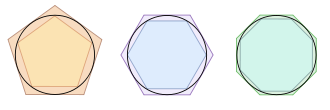
In
.Other developments
The development of archaeology has its roots in history and with those who were interested in the past, such as kings and queens who wanted to show past glories of their respective nations. The 5th-century-BCE
Greek scholarship under Roman rule
During the rule of Rome, famous historians such as Polybius, Livy and Plutarch documented the rise of the Roman Republic, and the organization and histories of other nations, while statesmen like Julius Caesar, Cicero, and others provided examples of the politics of the republic and Rome's empire and wars. The study of politics during this age was oriented toward understanding history, understanding methods of governing, and describing the operation of governments.
The Roman conquest of Greece did not diminish learning and culture in the Greek provinces.[126] On the contrary, the appreciation of Greek achievements in literature, philosophy, politics, and the arts by Rome's upper class coincided with the increased prosperity of the Roman Empire. Greek settlements had existed in Italy for centuries and the ability to read and speak Greek was not uncommon in Italian cities such as Rome.[126] Moreover, the settlement of Greek scholars in Rome, whether voluntarily or as slaves, gave Romans access to teachers of Greek literature and philosophy. Conversely, young Roman scholars also studied abroad in Greece and upon their return to Rome, were able to convey Greek achievements to their Latin leadership.[126] And despite the translation of a few Greek texts into Latin, Roman scholars who aspired to the highest level did so using the Greek language. The Roman statesman and philosopher Cicero (106 – 43 BCE) was a prime example. He had studied under Greek teachers in Rome and then in Athens and Rhodes. He mastered considerable portions of Greek philosophy, wrote Latin treatises on several topics, and even wrote Greek commentaries of Plato's Timaeus as well as a Latin translation of it, which has not survived.[126]
In the beginning, support for scholarship in Greek knowledge was almost entirely funded by the Roman upper class.[126] There were all sorts of arrangements, ranging from a talented scholar being attached to a wealthy household to owning educated Greek-speaking slaves.[126] In exchange, scholars who succeeded at the highest level had an obligation to provide advice or intellectual companionship to their Roman benefactors, or to even take care of their libraries. The less fortunate or accomplished ones would teach their children or perform menial tasks.[126] The level of detail and sophistication of Greek knowledge was adjusted to suit the interests of their Roman patrons. That meant popularizing Greek knowledge by presenting information that were of practical value such as medicine or logic (for courts and politics) but excluding subtle details of Greek metaphysics and epistemology. Beyond the basics, the Romans did not value natural philosophy and considered it an amusement for leisure time.[126]
Commentaries and encyclopedias were the means by which Greek knowledge was popularized for Roman audiences.[126] The Greek scholar Posidonius (c. 135-c. 51 BCE), a native of Syria, wrote prolifically on history, geography, moral philosophy, and natural philosophy. He greatly influenced Latin writers such as Marcus Terentius Varro (116-27 BCE), who wrote the encyclopedia Nine Books of Disciplines, which covered nine arts: grammar, rhetoric, logic, arithmetic, geometry, astronomy, musical theory, medicine, and architecture.[126] The Disciplines became a model for subsequent Roman encyclopedias and Varro's nine liberal arts were considered suitable education for a Roman gentleman. The first seven of Varro's nine arts would later define the seven liberal arts of medieval schools.[126] The pinnacle of the popularization movement was the Roman scholar Pliny the Elder (23/24–79 CE), a native of northern Italy, who wrote several books on the history of Rome and grammar. His most famous work was his voluminous Natural History.[126]
After the death of the Roman Emperor Marcus Aurelius in 180 CE, the favorable conditions for scholarship and learning in the Roman Empire were upended by political unrest, civil war, urban decay, and looming economic crisis.[126] In around 250 CE, barbarians began attacking and invading the Roman frontiers. These combined events led to a general decline in political and economic conditions. The living standards of the Roman upper class was severely impacted, and their loss of leisure diminished scholarly pursuits.[126] Moreover, during the 3rd and 4th centuries CE, the Roman Empire was administratively divided into two halves: Greek East and Latin West. These administrative divisions weakened the intellectual contact between the two regions.[126] Eventually, both halves went their separate ways, with the Greek East becoming the Byzantine Empire.[126] Christianity was also steadily expanding during this time and soon became a major patron of education in the Latin West. Initially, the Christian church adopted some of the reasoning tools of Greek philosophy in the 2nd and 3rd centuries CE to defend its faith against sophisticated opponents.[126] Nevertheless, Greek philosophy received a mixed reception from leaders and adherents of the Christian faith.[126] Some such as Tertullian (c. 155-c. 230 CE) were vehemently opposed to philosophy, denouncing it as heretic. Others such as Augustine of Hippo (354-430 CE) were ambivalent and defended Greek philosophy and science as the best ways to understand the natural world and therefore treated it as a handmaiden (or servant) of religion.[126] Education in the West began its gradual decline, along with the rest of Western Roman Empire, due to invasions by Germanic tribes, civil unrest, and economic collapse. Contact with the classical tradition was lost in specific regions such as Roman Britain and northern Gaul but continued to exist in Rome, northern Italy, southern Gaul, Spain, and North Africa.[126]
Middle Ages
In the Middle Ages, the classical learning continued in three major linguistic cultures and civilizations: Greek (the Byzantine Empire), Arabic (the Islamic world), and Latin (Western Europe).
Byzantine Empire
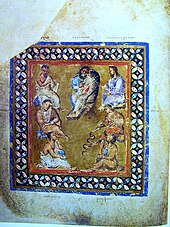
Preservation of Greek heritage
The fall of the Western Roman Empire led to a deterioration of the classical tradition in the western part (or Latin West) of Europe during the 5th century. In contrast, the Byzantine Empire resisted the barbarian attacks and preserved and improved the learning.[127]
While the Byzantine Empire still held learning centers such as Constantinople, Alexandria and Antioch, Western Europe's knowledge was concentrated in monasteries until the development of medieval universities in the 12th centuries. The curriculum of monastic schools included the study of the few available ancient texts and of new works on practical subjects like medicine[128] and timekeeping.[129]
In the sixth century in the Byzantine Empire, Isidore of Miletus compiled Archimedes' mathematical works in the Archimedes Palimpsest, where all Archimedes' mathematical contributions were collected and studied.
John Philoponus, another Byzantine scholar, was the first to question Aristotle's teaching of physics, introducing the theory of impetus.[130][131] The theory of impetus was an auxiliary or secondary theory of Aristotelian dynamics, put forth initially to explain projectile motion against gravity. It is the intellectual precursor to the concepts of inertia, momentum and acceleration in classical mechanics.[132] The works of John Philoponus inspired Galileo Galilei ten centuries later.[133][134]
Collapse
During the Fall of Constantinople in 1453, a number of Greek scholars fled to North Italy in which they fueled the era later commonly known as the "Renaissance" as they brought with them a great deal of classical learning including an understanding of botany, medicine, and zoology. Byzantium also gave the West important inputs: John Philoponus' criticism of Aristotelian physics, and the works of Dioscorides.[135]
Islamic world
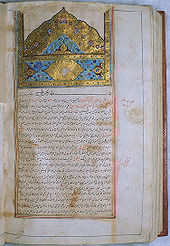
This was the period (8th–14th century CE) of the Islamic Golden Age where commerce thrived, and new ideas and technologies emerged such as the importation of papermaking from China, which made the copying of manuscripts inexpensive.
Translations and Hellenization
The eastward transmission of Greek heritage to Western Asia was a slow and gradual process that spanned over a thousand years, beginning with the Asian conquests of
Education and scholarly pursuits
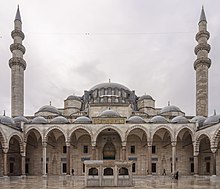
Madrasas were centers for many different religious and scientific studies and were the culmination of different institutions such as mosques based around religious studies, housing for out-of-town visitors, and finally educational institutions focused on the natural sciences.[136] Unlike Western universities, students at a madrasa would learn from one specific teacher, who would issue a certificate at the completion of their studies called an Ijazah. An Ijazah differs from a western university degree in many ways one being that it is issued by a single person rather than an institution, and another being that it is not an individual degree declaring adequate knowledge over broad subjects, but rather a license to teach and pass on a very specific set of texts.[137] Women were also allowed to attend madrasas, as both students and teachers, something not seen in high western education until the 1800s.[137] Madrasas were more than just academic centers. The Suleymaniye Mosque, for example, was one of the earliest and most well-known madrasas, which was built by Suleiman the Magnificent in the 16th century[138] The Suleymaniye Mosque was home to a hospital and medical college, a kitchen, and children's school, as well as serving as a temporary home for travelers.[138]
Higher education at a madrasa (or college) was focused on Islamic law and religious science and students had to engage in self-study for everything else.[5] And despite the occasional theological backlash, many Islamic scholars of science were able to conduct their work in relatively tolerant urban centers (e.g., Baghdad and Cairo) and were protected by powerful patrons.[5] They could also travel freely and exchange ideas as there were no political barriers within the unified Islamic state.[5] Islamic science during this time was primarily focused on the correction, extension, articulation, and application of Greek ideas to new problems.[5]
Advancements in mathematics
Most of the achievements by Islamic scholars during this period were in mathematics.
Scholars with geometric skills made significant improvements to the earlier classical texts on light and sight by Euclid, Aristotle, and Ptolemy.[5] The earliest surviving Arabic treatises were written in the 9th century by Abū Ishāq al-Kindī, Qustā ibn Lūqā, and (in fragmentary form) Ahmad ibn Isā. Later in the 11th century, Ibn al-Haytham (known as Alhazen in the West), a mathematician and astronomer, synthesized a new theory of vision based on the works of his predecessors.[5] His new theory included a complete system of geometrical optics, which was set in great detail in his Book of Optics.[5][143] His book was translated into Latin and was relied upon as a principal source on the science of optics in Europe until the 17th century.[5]
Institutionalization of medicine
The medical sciences were prominently cultivated in the Islamic world.[5] The works of Greek medical theories, especially those of Galen, were translated into Arabic and there was an outpouring of medical texts by Islamic physicians, which were aimed at organizing, elaborating, and disseminating classical medical knowledge.[5] Medical specialties started to emerge, such as those involved in the treatment of eye diseases such as cataracts. Ibn Sina (known as Avicenna in the West, c. 980–1037) was a prolific Persian medical encyclopedist[144] wrote extensively on medicine,[145][146] with his two most notable works in medicine being the Kitāb al-shifāʾ ("Book of Healing") and The Canon of Medicine, both of which were used as standard medicinal texts in both the Muslim world and in Europe well into the 17th century. Amongst his many contributions are the discovery of the contagious nature of infectious diseases,[145] and the introduction of clinical pharmacology.[147] Institutionalization of medicine was another important achievement in the Islamic world. Although hospitals as an institution for the sick emerged in the Byzantium empire, the model of institutionalized medicine for all social classes was extensive in the Islamic empire and was scattered throughout. In addition to treating patients, physicians could teach apprentice physicians, as well write and do research. The discovery of the pulmonary transit of blood in the human body by Ibn al-Nafis occurred in a hospital setting.[5]
Decline
Islamic science began its decline in the 12th–13th century, before the
Western Europe
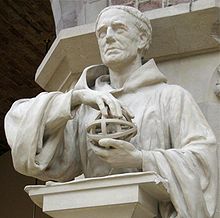
By the eleventh century, most of Europe had become Christian; stronger monarchies emerged; borders were restored; technological developments and agricultural innovations were made, increasing the food supply and population. Classical Greek texts were translated from Arabic and Greek into Latin, stimulating scientific discussion in Western Europe.[149]
In classical antiquity, Greek and Roman taboos had meant that dissection was usually banned, but in the Middle Ages medical teachers and students at Bologna began to open human bodies, and Mondino de Luzzi (c. 1275–1326) produced the first known anatomy textbook based on human dissection.[150][151]
As a result of the Pax Mongolica, Europeans, such as Marco Polo, began to venture further and further east. The written accounts of Polo and his fellow travelers inspired other Western European maritime explorers to search for a direct sea route to Asia, ultimately leading to the Age of Discovery.[152]
Technological advances were also made, such as the early flight of Eilmer of Malmesbury (who had studied mathematics in 11th-century England),[153] and the metallurgical achievements of the Cistercian blast furnace at Laskill.[154][155]
Medieval universities
An intellectual revitalization of Western Europe started with the birth of medieval universities in the 12th century. These urban institutions grew from the informal scholarly activities of learned friars who visited monasteries, consulted libraries, and conversed with other fellow scholars.[156] A friar who became well-known would attract a following of disciples, giving rise to a brotherhood of scholars (or collegium in Latin). A collegium might travel to a town or request a monastery to host them. However, if the number of scholars within a collegium grew too large, they would opt to settle in a town instead.[156] As the number of collegia within a town grew, the collegia might request that their king grant them a charter that would convert them into a universitas.[156] Many universities were chartered during this period, with the first in Bologna in 1088, followed by Paris in 1150, Oxford in 1167, and Cambridge in 1231.[156] The granting of a charter meant that the medieval universities were partially sovereign and independent from local authorities.[156] Their independence allowed them to conduct themselves and judge their own members based on their own rules. Furthermore, as initially religious institutions, their faculties and students were protected from capital punishment (e.g., gallows).[156] Such independence was a matter of custom, which could, in principle, be revoked by their respective rulers if they felt threatened. Discussions of various subjects or claims at these medieval institutions, no matter how controversial, were done in a formalized way so as to declare such discussions as being within the bounds of a university and therefore protected by the privileges of that institution's sovereignty.[156] A claim could be described as ex cathedra (literally "from the chair", used within the context of teaching) or ex hypothesi (by hypothesis). This meant that the discussions were presented as purely an intellectual exercise that did not require those involved to commit themselves to the truth of a claim or to proselytize. Modern academic concepts and practices such as academic freedom or freedom of inquiry are remnants of these medieval privileges that were tolerated in the past.[156]
The curriculum of these medieval institutions centered on the
Translations of Greek and Arabic sources
Contact with the Byzantine Empire,
At the beginning of the 13th century, there were reasonably accurate Latin translations of the main works of almost all the intellectually crucial ancient authors, allowing a sound transfer of scientific ideas via both the universities and the monasteries. By then, the natural philosophy in these texts began to be extended by
Medieval science
The first half of the 14th century saw much important scientific work, largely within the framework of scholastic commentaries on Aristotle's scientific writings.[163] William of Ockham emphasized the principle of parsimony: natural philosophers should not postulate unnecessary entities, so that motion is not a distinct thing but is only the moving object[164] and an intermediary "sensible species" is not needed to transmit an image of an object to the eye.[165] Scholars such as Jean Buridan and Nicole Oresme started to reinterpret elements of Aristotle's mechanics. In particular, Buridan developed the theory that impetus was the cause of the motion of projectiles, which was a first step towards the modern concept of inertia.[166] The Oxford Calculators began to mathematically analyze the kinematics of motion, making this analysis without considering the causes of motion.[167]
In 1348, the Black Death and other disasters sealed a sudden end to philosophic and scientific development. Yet, the rediscovery of ancient texts was stimulated by the Fall of Constantinople in 1453, when many Byzantine scholars sought refuge in the West. Meanwhile, the introduction of printing was to have great effect on European society. The facilitated dissemination of the printed word democratized learning and allowed ideas such as algebra to propagate more rapidly. These developments paved the way for the Scientific Revolution, where scientific inquiry, halted at the start of the Black Death, resumed.[168][169]
Renaissance
Revival of learning
The renewal of learning in Europe began with 12th century
The discovery of Cristallo contributed to the advancement of science in the period as well with its appearance out of Venice around 1450. The new glass allowed for better spectacles and eventually to the inventions of the telescope and microscope.
Theophrastus' work on rocks, Peri lithōn, remained authoritative for millennia: its interpretation of fossils was not overturned until after the Scientific Revolution.
During the
In archaeology, the 15th and 16th centuries saw the rise of
Scientific Revolution and birth of New Science

The
Other significant scientific advances were made during this time by
Heliocentrism
The heliocentric astronomical model of the universe was refined by Nicolaus Copernicus. Copernicus proposed the idea that the Earth and all heavenly spheres, containing the planets and other objects in the cosmos, rotated around the Sun.[175] His heliocentric model also proposed that all stars were fixed and did not rotate on an axis, nor in any motion at all.[176] His theory proposed the yearly rotation of the Earth and the other heavenly spheres around the Sun and was able to calculate the distances of planets using deferents and epicycles. Although these calculations were not completely accurate, Copernicus was able to understand the distance order of each heavenly sphere. The Copernican heliocentric system was a revival of the hypotheses of Aristarchus of Samos and Seleucus of Seleucia.[177] Aristarchus of Samos did propose that the Earth rotated around the Sun but did not mention anything about the other heavenly spheres' order, motion, or rotation.[178] Seleucus of Seleucia also proposed the rotation of the Earth around the Sun but did not mention anything about the other heavenly spheres. In addition, Seleucus of Seleucia understood that the Moon rotated around the Earth and could be used to explain the tides of the oceans, thus further proving his understanding of the heliocentric idea.[179]
Newly defined scientific method
The scientific method was also better developed as the modern way of thinking emphasized experimentation and reason over traditional considerations. Galileo ("Father of Modern Physics") also made use of experiments to validate physical theories, a key element of the scientific method.
Age of Enlightenment
Continuation of Scientific Revolution
The Scientific Revolution continued into the Age of Enlightenment, which accelerated the development of modern science.
Planets and orbits
The heliocentric model revived by Nicolaus Copernicus was followed by the model of planetary motion given by Johannes Kepler in the early 17th century, which proposed that the planets follow elliptical orbits, with the Sun at one focus of the ellipse.
Calculus and Newtonian mechanics
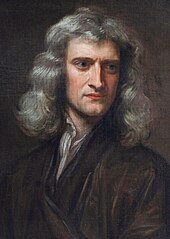
In 1687, Isaac Newton published the Principia Mathematica, detailing two comprehensive and successful physical theories: Newton's laws of motion, which led to classical mechanics; and Newton's law of universal gravitation, which describes the fundamental force of gravity.
Emergence of chemistry
A decisive moment came when "chemistry" was distinguished from alchemy by Robert Boyle in his work The Sceptical Chymist, in 1661; although the alchemical tradition continued for some time after his work. Other important steps included the gravimetric experimental practices of medical chemists like William Cullen, Joseph Black, Torbern Bergman and Pierre Macquer and through the work of Antoine Lavoisier ("father of modern chemistry") on oxygen and the law of conservation of mass, which refuted phlogiston theory. Modern chemistry emerged from the sixteenth through the eighteenth centuries through the material practices and theories promoted by alchemy, medicine, manufacturing and mining.[180][181][182]
Circulatory system
William Harvey published De Motu Cordis in 1628, which revealed his conclusions based on his extensive studies of vertebrate circulatory systems.[174] He identified the central role of the heart, arteries, and veins in producing blood movement in a circuit, and failed to find any confirmation of Galen's pre-existing notions of heating and cooling functions.[183] The history of early modern biology and medicine is often told through the search for the seat of the soul.[184] Galen in his descriptions of his foundational work in medicine presents the distinctions between arteries, veins, and nerves using the vocabulary of the soul.[185]
Scientific societies and journals
A critical innovation was the creation of permanent scientific societies and their scholarly journals, which dramatically sped the diffusion of new ideas. Typical was the founding of the
Developments in geology
Geology did not undergo systematic restructuring during the
Post-Scientific Revolution
Bioelectricity
During the late 18th century, researchers such as Hugh Williamson[188] and John Walsh experimented on the effects of electricity on the human body. Further studies by Luigi Galvani and Alessandro Volta established the electrical nature of what Volta called galvanism.[189][190]
Developments in geology

Modern geology, like modern chemistry, gradually evolved during the 18th and early 19th centuries.
Birth of modern economics
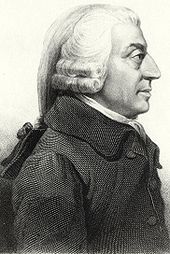
The basis for
Social science
Anthropology can best be understood as an outgrowth of the Age of Enlightenment. It was during this period that Europeans attempted systematically to study human behavior. Traditions of jurisprudence, history, philology and sociology developed during this time and informed the development of the social sciences of which anthropology was a part.
19th century
The 19th century saw the birth of science as a profession. William Whewell had coined the term scientist in 1833,[192] which soon replaced the older term natural philosopher.
Developments in physics
In physics, the behavior of electricity and magnetism was studied by
Discovery of Neptune
In astronomy, the planet Neptune was discovered. Advances in astronomy and in optical systems in the 19th century resulted in the first observation of an asteroid (1 Ceres) in 1801, and the discovery of Neptune in 1846.
Developments in mathematics
In mathematics, the notion of complex numbers finally matured and led to a subsequent analytical theory; they also began the use of
Developments in chemistry
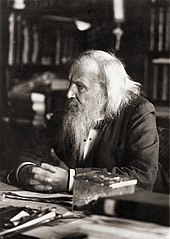
In chemistry,
Age of the Earth
Over the first half of the 19th century, geologists such as
Evolution and inheritance
Perhaps the most prominent, controversial, and far-reaching theory in all of science has been the theory of
Germ theory
Another important landmark in medicine and biology were the successful efforts to prove the
Schools of economics
Founding of psychology
Psychology as a scientific enterprise that was independent from philosophy began in 1879 when Wilhelm Wundt founded the first laboratory dedicated exclusively to psychological research (in Leipzig). Other important early contributors to the field include Hermann Ebbinghaus (a pioneer in memory studies), Ivan Pavlov (who discovered classical conditioning), William James, and Sigmund Freud. Freud's influence has been enormous, though more as cultural icon than a force in scientific psychology.
Modern sociology
Modern sociology emerged in the early 19th century as the academic response to the modernization of the world. Among many early sociologists (e.g., Émile Durkheim), the aim of sociology was in structuralism, understanding the cohesion of social groups, and developing an "antidote" to social disintegration. Max Weber was concerned with the modernization of society through the concept of rationalization, which he believed would trap individuals in an "iron cage" of rational thought. Some sociologists, including Georg Simmel and W. E. B. Du Bois, used more microsociological, qualitative analyses. This microlevel approach played an important role in American sociology, with the theories of George Herbert Mead and his student Herbert Blumer resulting in the creation of the symbolic interactionism approach to sociology. In particular, just Auguste Comte, illustrated with his work the transition from a theological to a metaphysical stage and, from this, to a positive stage. Comte took care of the classification of the sciences as well as a transit of humanity towards a situation of progress attributable to a re-examination of nature according to the affirmation of 'sociality' as the basis of the scientifically interpreted society.[198]
Romanticism
The
20th century
Science advanced dramatically during the 20th century. There were new and radical developments in the
Theory of relativity and quantum mechanics
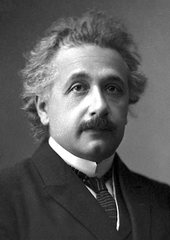
The beginning of the 20th century brought the start of a revolution in physics. The long-held theories of Newton were shown not to be correct in all circumstances. Beginning in 1900,
Big Bang
The observation by
Big science
In 1938
Though the process had begun with the invention of the
Advances in genetics

In the early 20th century, the study of heredity became a major investigation after the rediscovery in 1900 of the laws of inheritance developed by
Space exploration
In 1925, Cecilia Payne-Gaposchkin determined that stars were composed mostly of hydrogen and helium.[212] She was dissuaded by astronomer Henry Norris Russell from publishing this finding in her PhD thesis because of the widely held belief that stars had the same composition as the Earth.[213] However, four years later, in 1929, Henry Norris Russell came to the same conclusion through different reasoning and the discovery was eventually accepted.[213]
In 1987, supernova
Neuroscience as a distinct discipline
The understanding of neurons and the nervous system became increasingly precise and molecular during the 20th century. For example, in 1952,
Plate tectonics
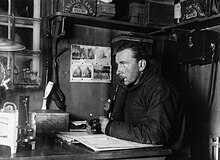
Geologists' embrace of plate tectonics became part of a broadening of the field from a study of rocks into a study of the Earth as a planet. Other elements of this transformation include: geophysical studies of the interior of the Earth, the grouping of geology with meteorology and oceanography as one of the "earth sciences", and comparisons of Earth and the solar system's other rocky planets.
Applications
In terms of applications, a massive number of new technologies were developed in the 20th century. Technologies such as
Einstein's paper "On the Quantum Theory of Radiation" outlined the principles of the stimulated emission of photons. This led to the invention of the
Based on wireless transmission of electromagnetic radiation and global networks of cellular operation, the mobile phone became a primary means to access the internet.[218]
Developments in political science and economics
In political science during the 20th century, the study of ideology, behaviouralism and international relations led to a multitude of 'pol-sci' subdisciplines including
Developments in psychology, sociology, and anthropology
Psychology in the 20th century saw a rejection of Freud's theories as being too unscientific, and a reaction against
American sociology in the 1940s and 1950s was dominated largely by
In the mid-20th century, much of the methodologies of earlier anthropological and ethnographical study were reevaluated with an eye towards research ethics, while at the same time the scope of investigation has broadened far beyond the traditional study of "primitive cultures".
21st century

Higgs boson
On July 4, 2012, physicists working at CERN's Large Hadron Collider announced that they had discovered a new subatomic particle greatly resembling the Higgs boson, a potential key to an understanding of why elementary particles have mass and indeed to the existence of diversity and life in the universe.[222] For now, some physicists are calling it a "Higgslike" particle.[222] Peter Higgs was one of six physicists, working in three independent groups, who, in 1964, invented the notion of the Higgs field ("cosmic molasses"), along with Tom Kibble, Carl Hagen, Gerald Guralnik, François Englert and Robert Brout.[222]
See also
- 2020s in science and technology
- History and philosophy of science
- History of measurement
- History of astronomy
- History of biology
- History of chemistry
- History of Earth science
- History of physics
- History of the social sciences
- History of technology
- History of scholarship
- History of science policy
- List of experiments
- List of Nobel laureates
- List of scientists
- List of years in science
- Materialism Controversy
- Multiple discovery
- Science tourism
- Sociology of the history of science
- Timelines of science
- Yuasa Phenomenon - Migration of center of activity of world science
References
- ISBN 978-0367562984. Archivedfrom the original on 5 May 2021. Retrieved 8 June 2021.
- ^ ISBN 978-0-226-48205-7.
- ^ ISBN 978-052-1-68957-1.
- ^ ISBN 978-0-226-48205-7.
- ^ ISBN 978-0-226-48205-7.
- ISBN 978-0-226-48205-7.
- S2CID 224789083. Retrieved 10 February 2024.
- ^ Küskü, Elif Aslan (1 January 2022). "Examination of Scientific Revolution Medicine on the Human Body / Bilimsel Devrim Tıbbını İnsan Bedeni Üzerinden İncelemek". The Legends: Journal of European History Studies. Archived from the original on 12 January 2023. Retrieved 28 September 2022.
- from the original on 18 November 2012. Retrieved 20 February 2012.
- ISBN 978-0-199-56741-6.
- ISBN 978-0-521-34262-9.
- ^ ISBN 978-0-226-48205-7.
- ^ Del Soldato, Eva (2016). Zalta, Edward N. (ed.). The Stanford Encyclopedia of Philosophy (Fall 2016 ed.). Metaphysics Research Lab, Stanford University. Archived from the original on 11 December 2019. Retrieved 1 June 2018.
- ISBN 978-052-1-68957-1.
- ^ ISBN 978-1316649701.
- ^ ISBN 978-0226365763.
- ISBN 978-0226365763.
- ISBN 978-0226365763.
- ISBN 978-0226365763.
- ISBN 978-0226365763.
- ISBN 978-0-226-08928-7.
- ^ The Oxford English Dictionary dates the origin of the word "scientist" to 1834.
- ISBN 978-0-226-31783-0.
- ^ ISBN 978-0226365763.
- ^ ISBN 978-0226365763.
- ISBN 978-0226365763.
- ^
ISBN 9783110820423. Retrieved 13 October 2023.
In historic reflections on art, cyclic schemas play a prominent role. This is a difference between art history and science history. The idea of linear progress simply does not apply in the esthetic domain.
- OCLC 14692886.
- )
- ^
Golinski, Jan (22 July 2008) [1998]. Making Natural Knowledge: Constructivism and the History of Science. Cambridge history of science (revised ed.). Chicago: University of Chicago Press. p. 188. ISBN 9780226302324. Retrieved 13 October 2023.
[...] historical writing [...] has largely abandoned the aim of telling a story of science's universal progress.
- ^
Thomas, Norman (1961). Great Dissenters. Norton. p. 25. Retrieved 13 October 2023.
[...] the brilliant Periclean Age, according to Dr. A. E. Taylor, witnessed one of the periodical bankruptcies of science [...].
- OCLC 1235416152.)
{{cite book}}: CS1 maint: location missing publisher (link - ISBN 978-0-8018-7038-5.
The conflict thesis, at least in its simple form, is now widely perceived as a wholly inadequate intellectual framework within which to construct a sensible and realistic historiography of Western science.
- ISBN 978-0226750200.
In the late Victorian period it was common to write about the 'warfare between science and religion' and to presume that the two bodies of culture must always have been in conflict. However, it is a very long time since these attitudes have been held by historians of science.
- ^ Brooke, J. H. (1991). Science and Religion: Some Historical Perspectives. Cambridge University Press. p. 42.
In its traditional forms, the conflict thesis has been largely discredited.
- ^
ISBN 9781317546382. Retrieved 13 October 2023.
At the close of the twentieth century, proponents of the conflict thesis are well represented by Richard Dawkins, E. O. Wilson and Daniel Dennett.
- )
- OCLC 1048657291.
- OCLC 555643149.
- S2CID 147175644.
- S2CID 144777485.
- )
- (PDF) from the original on 15 June 2022. Retrieved 17 September 2022.
- S2CID 115323404.
- PMID 11983901.
- ^ Sean B. Carroll (24 May 2010),"Tracking the Ancestry of Corn Back 9,000 Years" New York Times Archived 30 August 2017 at the Wayback Machine.
- teosinte, 'the father of corn', helps the success and vitality of corn when planted between the rows of its 'children', maize.
- ISBN 978-0-9540867-1-8.
- ISBN 978-0-300-07814-5.
- hdl:1880/51835. Archived from the original(PDF) on 7 April 2008. Retrieved 9 March 2010.
- ^ "Edwin Smith papyrus: Egyptian medical book". Encyclopædia Britannica. Archived from the original on 1 November 2014. Retrieved 21 December 2016.
- ^ Lloyd, G.E.R. "The development of empirical research", in his Magic, Reason and Experience: Studies in the Origin and Development of Greek Science.
- ^ ISBN 978-1-57607-966-9. Archivedfrom the original on 5 February 2021. Retrieved 3 October 2020.
- ^ ISBN 978-0-684-19279-6. Retrieved 12 May 2018.
- ^ ISBN 978-90-04-12387-8. Archivedfrom the original on 3 August 2020. Retrieved 7 May 2020.
- ^ ISBN 978-0-310-20029-1. Archivedfrom the original on 3 August 2020. Retrieved 7 May 2020.
- ^ Biggs, R D. (2005). "Medicine, Surgery, and Public Health in Ancient Mesopotamia". Journal of Assyrian Academic Studies. 19 (1): 7–18.
- ISBN 978-90-04-13666-3. Archivedfrom the original on 3 August 2020. Retrieved 12 May 2018.
- ISBN 978-90-72371-63-8.
- S2CID 122508567.
- ISBN 978-0-7868-6362-4
- ISBN 978-0-674-53918-1. Archivedfrom the original on 29 January 2018. Retrieved 3 October 2020.
- ISBN 978-0-87220-575-8. Archivedfrom the original on 31 March 2021. Retrieved 3 October 2020.
- ISBN 978-0-8014-7452-1. Archivedfrom the original on 28 February 2022. Retrieved 3 October 2020.
- ^ ISBN 978-0691135267.
- from the original on 8 June 2021. Retrieved 8 June 2021.
- ISBN 978-0195112290.
- ^ "3: Early Indian culture – Indus civilisation". st-and.ac.uk.
- ^ Bisht, R.S. (1982). "Excavations at Banawali: 1974–77". In Possehl, Gregory L. (ed.). Harappan Civilization: A Contemporary Perspective. Oxford and IBH Publishing Co. pp. 113–124.
- ISBN 978-0-19-533611-5. Archivedfrom the original on 18 January 2017. Retrieved 7 May 2020.
- ^ Mainak Kumar Bose, Late Classical India, A. Mukherjee & Co., 1988, p. 277.
- ISBN 978-0-471-37568-5.
- ^ O'Connor, J.J. and E.F. Robertson. 2000. 'Indian Numerals' Archived 29 September 2007 at the Wayback Machine, MacTutor History of Mathematics Archive, School of Mathematics and Statistics, University of St. Andrews, Scotland.
- ^ George G. Joseph (1991). The crest of the peacock. London.
- ISBN 978-0691135267.
- ^ ISBN 978-1-4020-4425-0.
- ISBN 978-0195335231.
- S2CID 6787162.
- JSTOR 597102.name, Kauṭilya.
Trautmann, Thomas R. (1971). Kauṭilya and the Arthaśāstra: A Statistical Investigation of the Authorship and Evolution of the Text. Brill. p. 10.while in his character as author of an arthaśāstra he is generally referred to by his gotra
- ^ Mabbett 1964
Trautmann 1971:5 "the very last verse of the work...is the unique instance of the personal name Viṣṇugupta rather than the gotra name Kauṭilya in the Arthaśāstra. - ISBN 978-0-7391-0401-9.
- ISBN 9783540337836.
- ^ Needham (1986a), p. 208.
- ^ Needham p422
- ISBN 90-04-15605-4.
- ISBN 0-07-141279-4.
- ^ Minford & Lau (2002), 307; Balchin (2003), 26–27; Needham (1986a), 627; Needham (1986c), 484; Krebs (2003), 31.
- ^ Needham (1986a), 626.
- ^ Shen Kuo 沈括 (1086, last supplement dated 1091), Meng Ch'i Pi Than (夢溪筆談, Dream Pool Essays) as cited in Needham, Robinson & Huang 2004, p. 244
- ^ Needham (1986c), pp. 111, 165, 445, 448, 456–457, 469–471.
- ^ Agustín Udías, Searching the Heavens and the Earth: The History of Jesuit Observatories. (Dordrecht, The Netherlands: Kluwer Academic Publishers, 2003). p. 53
- ^ PMID 31204349– via Project MUSE.
- ^ PMID 18650901– via www.nature.com.
- ^ Needham & Wang (1954), p. 581.
- ISBN 978-1-885923-76-9.
- ^ a b Britannica, The Editors of Encyclopaedia. "Mesoamerican civilization". Encyclopedia Britannica, 3 Feb. 2024, https://www.britannica.com/topic/Mesoamerican-civilization. Accessed 13 February 2024.
- ISBN 0-07-286311-0. p. 321
- ^ Smith, David Eugene and LeVeque, William Judson. "Numerals and numeral systems". Encyclopedia Britannica, 17 Dec. 2023, https://www.britannica.com/science/numeral. Accessed 13 February 2024.
- ISBN 978-1-885923-76-9.
- ISBN 978-1-885923-76-9.
- mythos to logos
- F.M. Cornford, Principium Sapientiae: The Origins of Greek Philosophical Thought, (Gloucester, Massachusetts, Peter Smith, 1971), p. 159.
- ^ a b Broad, William J. (6 April 2024). "The Eclipse That Ended a War and Shook the Gods Forever - Thales, a Greek philosopher 2,600 years ago, is celebrated for predicting a famous solar eclipse and founding what came to be known as science". The New York Times. Archived from the original on 6 April 2024.
- ISBN 978-0-7425-3329-5.
- ISBN 978-0-8014-0561-7.
- ISBN 978-0-7100-1903-5.
- ISBN 978-1-4088-3622-4.
- ^ Zalta, Edward N., ed. (2018). "Aristotle's Influence". Stanford Encyclopedia of Philosophy (Spring 2018 ed.).
- ISBN 978-0-19-285408-7.
- ^ Aristotle (7 January 2009). "De Caelo" [On the Heavens]. Translated by J. L. Stocks: The Internet Classics Archive. pp. 279 a17-30.
- S2CID 144547689– via Project MUSE.
- JSTOR 10.1086/432288. Archivedfrom the original on 4 December 2022. Retrieved 4 December 2022.
- G.E.R. Lloyd, Early Greek Science: Thales to Aristotle, (New York: W.W. Norton, 1970), pp. 144–146.
- ISBN 0-393-00780-4, p. 177.
- ^ Greek Science, many editions, such as the paperback by Penguin Books. Copyrights in 1944, 1949, 1953, 1961, 1963. The first quote above comes from Part 1, Chapter 1; the second, from Part 2, Chapter 4.
- PMID 17136067.
- ^ a b Kleisiaris CF, Sfakianakis C, Papathanasiou IV. Health care practices in ancient Greece: The Hippocratic ideal. J Med Ethics Hist Med. 2014 Mar 15;7:6. PMID 25512827; PMCID: PMC4263393.
- ^ PMID 25512827.
- S2CID 57571190.
- Casselman, Bill. "One of the Oldest Extant Diagrams from Euclid". University of British Columbia. Archivedfrom the original on 4 June 2012. Retrieved 26 September 2008.
- ISBN 978-0471543978.
The Elements of Euclid not only was the earliest major Greek mathematical work to come down to us, but also the most influential textbook of all times. [...]The first printed versions of the Elements appeared at Venice in 1482, one of the very earliest of mathematical books to be set in type; it has been estimated that since then at least a thousand editions have been published. Perhaps no book other than the Bible can boast so many editions, and certainly no mathematical work has had an influence comparable with that of Euclid's Elements.
- ISBN 978-0-02-318285-3.
Shortly after Euclid, compiler of the definitive textbook, came Archimedes of Syracuse (c. 287–212 BC.), the most original and profound mathematician of antiquity.
- ^ O'Connor, J.J.; Robertson, E.F. (February 1996). "A history of calculus". University of St Andrews. Archived from the original on 15 July 2007. Retrieved 7 August 2007.
- ^ "Pliny the Elder, The Natural History, BOOK XXXVII. THE NATURAL HISTORY OF PRECIOUS STONES". www.perseus.tufts.edu.
- ISBN 9781789145922.
- ^ ISBN 978-0-226-48205-7.
- ^ Lindberg, David. (1992) The Beginnings of Western Science. University of Chicago Press. p. 363.
- ISBN 978-0-226-74951-8.
- ISBN 978-0-85323-693-1.
- ISBN 978-0-415-18712-1.
- from Google's copy of 2008 reprint.
- ^ Duhem, Pierre (1913). "Physics, History of". In Herbermann, Charles G.; Pace, Edward A.; Pallen, Condé B.; Wynne, John J.; Shahan, Thomas J. (eds.). The Catholic Encyclopedia: An International Work of Reference on the Constitution, Doctrine, and History of the Catholic Church. Vol. 12. New York: Encyclopedia Press. p. 51. Archived from the original on 3 January 2014. Retrieved 19 April 2018.
- ^ a b Lindberg, David. (1992) The Beginnings of Western Science. University of Chicago Press. p. 162.
- ^ "John Philoponus". The Stanford Encyclopedia of Philosophy. Metaphysics Research Lab, Stanford University. 2018. Archived from the original on 22 April 2018. Retrieved 11 April 2018.
- ^ Lindberg, David. (1992). The Beginnings of Western Science. University of Chicago Press. p. 162.
- ISBN 978-1-4696-2014-5. Archivedfrom the original on 30 July 2022. Retrieved 25 November 2021.
- ^ from the original on 24 November 2021. Retrieved 24 November 2021.
- ^ a b "Süleymaniye Mosque, Turkey". www.architecturecourses.org. Archived from the original on 24 November 2021. Retrieved 24 November 2021.
- ISBN 978-0-684-16962-0.
- JSTOR 2709773.
- ^ Rabin, Sheila (2004). "Nicolaus Copernicus". Stanford Encyclopedia of Philosophy. Archived from the original on 15 July 2012. Retrieved 24 June 2012.
- ISBN 978-0-8147-8023-7.
- ^ Sameen Ahmed Khan Archived 5 March 2016 at the Wayback Machine, Arab Origins of the Discovery of the Refraction of Light; Roshdi Hifni Rashed (Picture) Awarded the 2007 King Faisal International Prize, Optics & Photonics News (OPN, Logo), Vol. 18, No. 10, pp. 22–23 (October 2007).
- ^ Nasr, Seyyed Hossein (2007). "Avicenna". Encyclopædia Britannica Online. Archived from the original on 31 October 2007. Retrieved 3 June 2010.
- ^ a b Jacquart, Danielle (2008). "Islamic Pharmacology in the Middle Ages: Theories and Substances". European Review (Cambridge University Press) 16: 219–227.
- ^ David W. Tschanz, MSPH, PhD (August 2003). "Arab Roots of European Medicine", Heart Views 4 (2).
- S2CID 45980791.
- ^ Erica Fraser. The Islamic World to 1600, University of Calgary.
- ^ Lindberg, David. (1992) The Beginnings of Western Science University of Chicago Press. p. 204.
- ISBN 978-0-674-03327-6. Archivedfrom the original on 20 January 2021. Retrieved 12 April 2018.
- ^ "Debunking a myth". Harvard University. 7 April 2011. Archived from the original on 28 July 2019. Retrieved 12 April 2018.
- ISBN 978-0313320439.
- ^ William of Malmesbury, Gesta Regum Anglorum / The history of the English kings, ed. and trans. R.A.B. Mynors, R.M. Thomson, and M. Winterbottom, 2 vols., Oxford Medieval Texts (1998–99)
- ^ R.W. Vernon, G. McDonnell and A. Schmidt, 'An integrated geophysical and analytical appraisal of early iron-working: three case studies' Historical Metallurgy 31(2) (1998), 72–75 79.
- ^ David Derbyshire, Henry "Stamped Out Industrial Revolution", The Daily Telegraph (21 June 2002)
- ^ ISBN 978-1316649701.
- ^ Huff, Toby. Rise of early modern science 2nd ed. pp. 180–181
- ^ Grant, Edward. "Science in the Medieval University", in James M. Kittleson and Pamela J. Transue, ed., Rebirth, Reform and Resilience: Universities in Transition, 1300–1700, Ohio State University Press, 1984, p. 68
- University of Stanford. Archivedfrom the original on 11 March 2017. Retrieved 14 September 2009.
- ^ "Rediscovering the Science of the Middle Ages". BioLogos. Archived from the original on 1 March 2023. Retrieved 26 October 2014.
- ^ "023-A03: The Middle Ages and the Birth of Science – International Catholic University". International Catholic University. Archived from the original on 26 October 2014. Retrieved 26 October 2014.
- (PDF) from the original on 23 July 2018. Retrieved 15 July 2019.
- ^ Edward Grant, The Foundations of Modern Science in the Middle Ages: Their Religious, Institutional, and Intellectual Contexts, (Cambridge Univ. Press, 1996), pp. 127–131.
- ^ Edward Grant, A Source Book in Medieval Science, (Harvard Univ. Press, 1974), p. 232
- ^ David C. Lindberg, Theories of Vision from al-Kindi to Kepler, (Chicago: Univ. of Chicago Pr., 1976), pp. 140–142.
- ^ Edward Grant, The Foundations of Modern Science in the Middle Ages: Their Religious, Institutional, and Intellectual Contexts, (Cambridge: Cambridge Univ. Press, 1996), pp. 95–97.
- ^ Edward Grant, The Foundations of Modern Science in the Middle Ages: Their Religious, Institutional, and Intellectual Contexts, (Cambridge Univ. Press, 1996), pp. 100–103.
- ^ Szalay, Jessie (29 June 2016). "The Renaissance: The 'Rebirth' of Science & Culture". Historical development. LiveScience.com. Archived from the original on 27 October 2018. Retrieved 19 July 2019.
- ISBN 978-0-02-912370-6. Archivedfrom the original on 3 August 2020. Retrieved 19 July 2019.
- Allen Debus, Man and Nature in the Renaissance, (Cambridge: Cambridge Univ. Pr., 1978).
- ^ Precise titles of these landmark books can be found in the collections of the Library of Congress. A list of these titles can be found in Bruno 1989
- ^ "What Is the Enlightenment and How Did It Transform Politics?". World101 from the Council on Foreign Relations.
- ^ See, for example, Heilbron 2003, pp. 741–744
- ^ ISBN 978-0415145787. Archivedfrom the original on 27 September 2021. Retrieved 27 September 2021.
- ISBN 978-0-19-956741-6.
- from the original on 4 December 2022. Retrieved 4 December 2022.
- JSTOR 986462.
- S2CID 39274542.
- from the original on 4 December 2022. Retrieved 4 December 2022.
- from the original on 30 July 2022. Retrieved 19 September 2014.
- ^ Florin George Calian. Alkimia Operativa and Alkimia Speculativa. Some Modern Controversies on the Historiography of Alchemy.
- from the original on 12 May 2021. Retrieved 28 April 2022.
- ^ Power, d'Arcey. Life of Harvey. Longmans, Green, & co.
- ^ Stanford (2003). "Ancient Theories of Soul". Plato.Stanford. Archived from the original on 7 August 2019. Retrieved 9 July 2018.
- ^ Galen, David (1984). Galen on Respiration and the arteries. UCSC library: Princeton University Press. p. 201.
- ^ Meyrick H. Carré, "The Formation of the Royal Society" History Today (Aug 1960) 10#8 pp 564–571.
- ^ Heilbron (2003), p. 741.
- .
- ^ Edwards, Paul (10 November 2021). "A Correction to the Record of Early Electrophysiology Research on the 250th Anniversary of a Historic Expedition to Île de Ré". HAL open-access archive. hal-03423498. Archived from the original on 6 May 2022. Retrieved 6 May 2022.
- S2CID 13035403.
- ^ Matthew Daniel Eddy (2008). The Language of Mineralogy: John Walker, Chemistry and the Edinburgh Medical School 1750–1800. Ashgate. Archived from the original on 3 September 2015. Retrieved 19 September 2014.
- ^ Snyder, Laura J. (23 December 2000). "William Whewell". Stanford Encyclopedia of Philosophy. The Metaphysics Research Lab, Stanford University. Archived from the original on 4 January 2010. Retrieved 3 March 2008.
- PMID 17152615– via PubMed.
- ^ Dastrup, R. Adam. "Chapter 3 Planet earth and Plate tectonics" – via pressbooks.howardcc.edu.
- ^ "Plate Tectonics". education.nationalgeographic.org.
- PMID 14223586. Archived from the original(PDF) on 3 March 2016. Retrieved 5 February 2016.
- OCLC 75299209. Archived from the original on 2 November 2014. Retrieved 9 September 2008.[page needed]
- )
- ISBN 978-0-7456-3469-2.
- ^ Magazine, Smithsonian; Greene, Brian. "Why String Theory Still Offers Hope We Can Unify Physics". Smithsonian Magazine.
- S2CID 4793163.
- ^ "Wilson's 1978 Nobel lecture" (PDF). nobelprize.org. Archived (PDF) from the original on 13 April 2005. Retrieved 23 March 2005.
- ^ Ronald K. Smeltzer. "Chien-Shiung Wu." Atomic Heritage Foundation, https://www.atomicheritage.org/profile/chien-shiung-wu Archived 15 September 2019 at the Wayback Machine. Accessed 26 Oct. 2017.
- ^ a b Biography.com Editors. "Chien-Shiung Wu." Biography.com, 2 June 2016, https://www.biography.com/people/chien-shiung-wu-053116 Archived 26 October 2017 at the Wayback Machine.
- .
- OCLC 43648512.
- ^ S2CID 4253007. Archived from the original(PDF) on 24 October 2017.
- ISBN 978-0-521-52486-5.
- S2CID 128410978.
- ISBN 978-0-520-27174-6.
- ISBN 978-0-674-97942-0.
- ^ Erik Gregersen. "Cecilia Payne-Gaposchkin | American Astronomer." Encyclopædia Britannica, https://www.britannica.com/biography/Cecilia-Payne-Gaposchkin Archived 8 October 2018 at the Wayback Machine.
- ^ a b Rachael Padman. "Cecilia Payne-Gaposchkin (1900–1979)." Newnham College Biographies, 2004, http://www.newn.cam.ac.uk/about/history/biographies/ Archived 25 March 2017 at the Wayback Machine.
- PMID 10845068.
- ^ American Society of Mechanical Engineers. Karl Benz Archived 28 November 2021 at the Wayback Machine.
- ^ "Computer Science vs. Software Engineering [Comparison Guide]".
- ^ Hecht, Jeff (10 August 2016). "The Bandwidth Bottleneck That is Throttling the Internet ". Scientific American.
- ^ Handley, Lucy. "Nearly three quarters of the world will use just their smartphones to access the internet by 2025". CNBC. Archived from the original on 28 September 2022. Retrieved 28 September 2022.
- hdl:10230/35942– via CrossRef.
- PMID 21086524– via CrossRef.
- ^ Little, William (5 October 2016). "Chapter 22: Social Interaction".
- ^ a b c Overbye, Dennis (4 July 2012). "Physicists Find Particle That Could Be the Higgs Boson". The New York Times. Archived from the original on 7 June 2021. Retrieved 7 June 2021.
Sources
- ISBN 978-0-8160-2137-6.
- Heilbron, John L., ed. (2003). The Oxford Companion to the History of Modern Science. Oxford University Press. ISBN 978-0-19-511229-0.
- Needham, Joseph; Wang, Ling (1954). Introductory Orientations. Science and Civilisation in China. Vol. 1. Cambridge University Press.
- Needham, Joseph (1986a). Mathematics and the Sciences of the Heavens and the Earth. Science and Civilisation in China. Vol. 3. Taipei: Caves Books Ltd.
- Needham, Joseph (1986c). Physics and Physical Technology, Part 2, Mechanical Engineering. Science and Civilisation in China. Vol. 4. Taipei: Caves Books Ltd.
- Needham, Joseph; Robinson, Kenneth G.; Huang, Jen-Yü (2004). "General Conclusions and Reflections". Science and Chinese society. Science and Civilisation in China. Vol. 7. Cambridge University Press.
- Sambursky, Shmuel (1974). Physical Thought from the Presocratics to the Quantum Physicists: an anthology selected, introduced and edited by Shmuel Sambursky. Pica Press. p. 584. ISBN 978-0-87663-712-8.
Further reading
- Agar, Jon (2012) Science in the Twentieth Century and Beyond, Polity Press. ISBN 978-0-7456-3469-2.
- ISBN 978-1-4020-5631-4.
- OCLC 9645583.
- Bowler, Peter J. (1993) The Norton History of the Environmental Sciences.
- Brock, W.H. (1993) The Norton History of Chemistry.
- ISBN 978-84-297-1380-0. (Includes a description of the history of science in England.)
- Byers, Nina and Gary Williams, ed. (2006) Out of the Shadows: Contributions of Twentieth-Century Women to Physics, Cambridge University Press ISBN 978-0-521-82197-1
- Herzenberg, Caroline L. (1986). Women Scientists from Antiquity to the Present Locust Hill Press ISBN 978-0-933951-01-3
- ISBN 978-0-226-45807-6.
- ISBN 978-0-19-568003-4
- Lakatos, Imre (1978). History of Science and its Rational Reconstructions published in The Methodology of Scientific Research Programmes: Philosophical Papers Volume 1. Cambridge University Press
- Levere, Trevor Harvey. (2001) Transforming Matter: A History of Chemistry from Alchemy to the Buckyball
- ISBN 978-0-521-59448-6.
- Lipphardt, Veronika/Ludwig, Daniel, Knowledge Transfer and Science Transfer, EGO – European History Online, Mainz: Institute of European History, 2011, retrieved: March 8, 2020 (pdf).
- Margolis, Howard (2002). It Started with Copernicus. ISBN 978-0-07-138507-7
- Mayr, Ernst. (1985). The Growth of Biological Thought: Diversity, Evolution, and Inheritance.
- North, John. (1995). The Norton History of Astronomy and Cosmology.
- Nye, Mary Jo, ed. (2002). The Cambridge History of Science, Volume 5: The Modern Physical and Mathematical Sciences
- Park, Katharine, and Lorraine Daston, eds. (2006) The Cambridge History of Science, Volume 3: Early Modern Science
- Porter, Roy, ed. (2003). The Cambridge History of Science, Volume 4: The Eighteenth Century
- ISBN 978-0-521-22599-1
- Slotten, Hugh Richard, ed. (2014) The Oxford Encyclopedia of the History of American Science, Medicine, and Technology.
External links
- 'What is the History of Science', British Academy
- British Society for the History of Science
- "Scientific Change". Internet Encyclopedia of Philosophy.
- The CNRS History of Science and Technology Research Center in Paris (France) (in French)
- Henry Smith Williams, History of Science, Vols 1–4, online text
- Digital Archives of the National Institute of Standards and Technology (NIST)
- Digital facsimiles of books from the History of Science Collection, Linda Hall Library Digital Collections
- Division of History of Science and Technology of the International Union of History and Philosophy of Science
- Giants of Science (website of the Institute of National Remembrance)
- History of Science Digital Collection: Utah State University – Contains primary sources by such major figures in the history of scientific inquiry as Otto Brunfels, Charles Darwin, Erasmus Darwin, Carolus Linnaeus Antony van Leeuwenhoek, Jan Swammerdam, James Sowerby, Andreas Vesalius, and others.
- History of Science Society ("HSS") Archived 15 September 2020 at the Wayback Machine
- Inter-Divisional Teaching Commission (IDTC) of the International Union for the History and Philosophy of Science (IUHPS) Archived 13 January 2020 at the Wayback Machine
- International Academy of the History of Science
- International History, Philosophy and Science Teaching Group
- IsisCB Explore: History of Science Index An open access discovery tool
- Museo Galileo – Institute and Museum of the History of Science in Florence, Italy
- National Center for Atmospheric Research (NCAR) Archives
- The official site of the Nobel Foundation. Features biographies and info on Nobel laureates
- The Royal Society, trailblazing science from 1650 to date Archived 18 August 2015 at the Wayback Machine
- The Vega Science Trust Free to view videos of scientists including Feynman, Perutz, Rotblat, Born and many Nobel Laureates.


